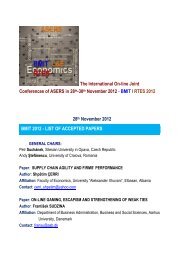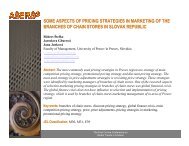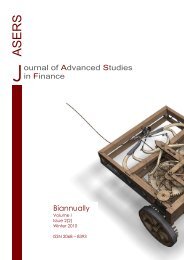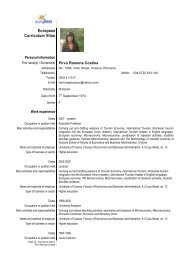Can Shift to a Funded Pension System Affect - ASERS
Can Shift to a Funded Pension System Affect - ASERS
Can Shift to a Funded Pension System Affect - ASERS
You also want an ePaper? Increase the reach of your titles
YUMPU automatically turns print PDFs into web optimized ePapers that Google loves.
Theoretical and Practical Research in Economic Fields<br />
diversified, adverse external shocks affect firms not only through final demand, but also through a rupture in the<br />
flow of inputs received from their suppliers.<br />
3. Trade Collapse: the Role of Supply Chains<br />
15<br />
10<br />
5<br />
0<br />
-5<br />
-10<br />
-15<br />
1960 1965 1970 1975 1980 1985 1990 1995 2000 2005<br />
Figure 1. World merchandise exports and GDP, 1960-2009 (Real annual percentage change)<br />
Source: WTO, International Trade Statistics and 2009 forecasts<br />
• Trade Elasticity<br />
Various authors attribute the large drop in trade registered since the end of 2008 (Figure 1), with an<br />
apparent trade-GDP elasticity larger than 5, <strong>to</strong> the leverage effect induced by the geographical fragmentation of<br />
production (Tanaka 2009; Yi 2009). Others contest the hypothesis of higher demand elasticity due <strong>to</strong> vertical<br />
integration (Benassy – Queré et al. 2009) because it affects only the relative volume of trade in relation <strong>to</strong> GDP,<br />
while elasticity should remain constant in a general equilibrium context. It is probable that the observed reality<br />
lays somewhere in-between the variable trade elasticity hypothesis and the constant one.<br />
As seen in Figure 2, the world trade elasticity is shaped like an inversed “U”, increasing at the end of the<br />
1980s and decreasing in the most recent years. Because elasticity should indeed remain constant in an<br />
equilibrium context, this humped shape probably signals a long-term transition from one steady state <strong>to</strong> a new<br />
one.<br />
3.5<br />
Exports <strong>to</strong>tal<br />
GDP<br />
3.0<br />
2.5<br />
2.0<br />
1.5<br />
1.0<br />
1990 1995 2000 2005 2009<br />
Figure 2. World: GDP Elasticity of Imports, 10 year average<br />
Note: Rolling windows of 10 years; the date indicates the last year. World GDP is the sum of countries‟ data using<br />
market exchange rates; 2009 based on forecasts.<br />
Source: Escaith, Lindenberg, and Miroudot (2010)<br />
32











